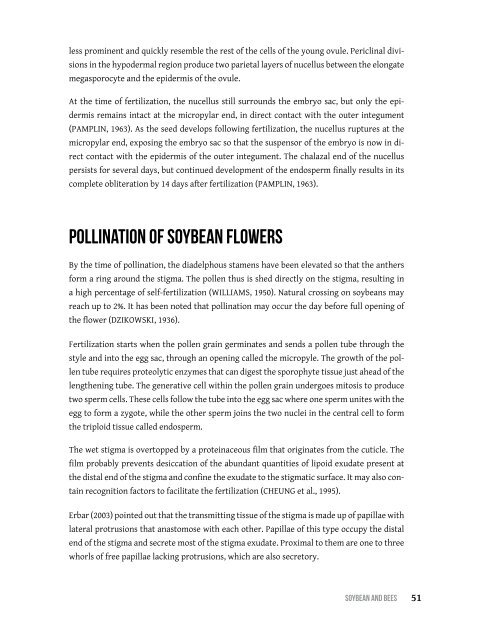Soybean and Bees
You also want an ePaper? Increase the reach of your titles
YUMPU automatically turns print PDFs into web optimized ePapers that Google loves.
less prominent <strong>and</strong> quickly resemble the rest of the cells of the young ovule. Periclinal divisions<br />
in the hypodermal region produce two parietal layers of nucellus between the elongate<br />
megasporocyte <strong>and</strong> the epidermis of the ovule.<br />
At the time of fertilization, the nucellus still surrounds the embryo sac, but only the epidermis<br />
remains intact at the micropylar end, in direct contact with the outer integument<br />
(Pamplin, 1963). As the seed develops following fertilization, the nucellus ruptures at the<br />
micropylar end, exposing the embryo sac so that the suspensor of the embryo is now in direct<br />
contact with the epidermis of the outer integument. The chalazal end of the nucellus<br />
persists for several days, but continued development of the endosperm finally results in its<br />
complete obliteration by 14 days after fertilization (Pamplin, 1963).<br />
Pollination of soybean flowers<br />
By the time of pollination, the diadelphous stamens have been elevated so that the anthers<br />
form a ring around the stigma. The pollen thus is shed directly on the stigma, resulting in<br />
a high percentage of self-fertilization (Williams, 1950). Natural crossing on soybeans may<br />
reach up to 2%. It has been noted that pollination may occur the day before full opening of<br />
the flower (Dzikowski, 1936).<br />
Fertilization starts when the pollen grain germinates <strong>and</strong> sends a pollen tube through the<br />
style <strong>and</strong> into the egg sac, through an opening called the micropyle. The growth of the pollen<br />
tube requires proteolytic enzymes that can digest the sporophyte tissue just ahead of the<br />
lengthening tube. The generative cell within the pollen grain undergoes mitosis to produce<br />
two sperm cells. These cells follow the tube into the egg sac where one sperm unites with the<br />
egg to form a zygote, while the other sperm joins the two nuclei in the central cell to form<br />
the triploid tissue called endosperm.<br />
The wet stigma is overtopped by a proteinaceous film that originates from the cuticle. The<br />
film probably prevents desiccation of the abundant quantities of lipoid exudate present at<br />
the distal end of the stigma <strong>and</strong> confine the exudate to the stigmatic surface. It may also contain<br />
recognition factors to facilitate the fertilization (Cheung et al., 1995).<br />
Erbar (2003) pointed out that the transmitting tissue of the stigma is made up of papillae with<br />
lateral protrusions that anastomose with each other. Papillae of this type occupy the distal<br />
end of the stigma <strong>and</strong> secrete most of the stigma exudate. Proximal to them are one to three<br />
whorls of free papillae lacking protrusions, which are also secretory.<br />
SoybeAn <strong>and</strong> bees<br />
51


